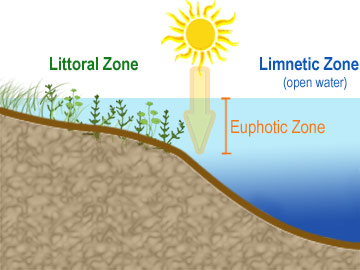Sumi Vora
AP Environmental Science ♻️
252 resourcesSee Units
As we said, biomes can be both terrestrial and aquatic, representing large patterns of climate and species coexistence that can be divided into distinct regions.
Aquatic biomes are ecosystems classified by the presence of water (freshwater or marine) and the type of organisms that live in them.
Freshwater biomes include lakes, ponds, rivers, and streams. With low salinity in the water, these bodies support a variety of plant and animal life, including fish, amphibians, reptiles, mammals, and birds.
Marine biomes include oceans, coral reefs, and estuaries. These biomes have high salinity and support a diverse array of plant and animal life, including fish, shellfish, seaweeds, and marine mammals.
Aquatic biomes are important for the health of the planet, as they provide a habitat for a wide range of plant and animal species and play a key role in the global water cycle. They are also important for human activities, such as fishing, tourism, and recreation.
Aquatic Biomes
Streams and Rivers
Streams and rivers both have flowing fresh water. Rivers are usually wider and carry larger amounts of water than streams, although almost all streams will eventually join back into a river.. Since the water is constantly flowing, algae and aquatic plants are rare, and most organic matter is often from terrestrial biomes (like a fallen leaf). Since these biomes have fast-moving water, they usually have higher amounts of oxygen, which supports the presence of freshwater fish.
Lakes and Ponds
Lakes and ponds have standing freshwater, with an end deep enough to prevent emergent vegetation (where aquatic plants grow onto land). Lakes are generally larger than ponds.

Source: RMB Env Lab
Lakes with a high level of productivity are called eutrophic lakes.
Moderately productive lakes are mesotropic.
Oligotrophic lakes have low levels of nitrogen and phosphorus and are the least productive.
Lakes and ponds can be divided into several zones.
The littoral zone is the shallow area of water near the shore where most of the photosynthesis occurs.
The deeper open water is called the limnetic zone, which goes as deep as the sunlight can penetrate.
Below the limnetic zone is the profundal zone, which is too deep for the sunlight to reach and therefore supports very few organisms.
The muddy bottom of the lake is the benthic zone.
Freshwater Wetlands
Freshwater wetlands are one of the most productive global biomes. They are submerged in water for part of or all of the year, but they are shallow enough in most parts to support emergent vegetation. Their soils are often saturated partially or fully in water, which allows for specialized living conditions and lots of present nutrients. They prevent flooding and drought with extensive rainfall intake, filter pollutants from water, and give birds a place to migrate for breeding.
Salt Marshes
Salt marshes are marshes that contain non woody emergent vegetation and are flooded either partially or entirely with salt water as opposed to freshwater. They are often found along the coast in temperate climates. Salt marshes are often located along estuaries, where freshwater rivers meet salt water. Because these rivers carry nutrient-rich material to the ocean, salt marshes are extremely productive biomes for plants and algae. They can also prevent flooding and extreme coastal erosion.
Mangrove Swamps
Mangrove swamps are similar to wetlands -- they contain trees whose roots are submerged in water. These roots are dense and can help preserve natural infrastructure as well as prevent natural disaster effects from hurricanes or storms. However, mangrove trees can survive in salt water as well, so mangrove swamps are located either in estuaries or in shallow salt water areas. This biome is located in tropical and subtropical areas.
Source: Unsplash
Intertidal Zones
Intertidal zones are narrow bands of coastline between the levels of high tide and low tide. During high tide, the zone is submerged in water, so conditions are relatively stable. However, during low tide, the water recedes, which exposes organisms to harsh conditions. Intertidal zones are home to many organisms such as barnacles, sponges, sea stars, and crustaceans that are able to cling to their rocky surface. Species that live in this zone must be used to constantly changing conditions such as salinity level adjustment and exposure to sunlight.
Coral Reefs
Coral reefs are found in warm, shallow waters. The corals are made up of tiny animals that produce limestone to form a hard external skeleton. Corals are always found in warm, shallow waters that sunlight can penetrate because it relies on photosynthetic algae for food.
Coral reefs are Earth’s most diverse marine biome, but pollutants have created a growing problem in coral reefs. Coral bleaching is a phenomenon in which the algae inside corals die, which causes the corals to die as well. The ocean is currently experiencing acidification due to climate change, which lowers the pH of the ocean water and causes erosion, or bleaching, of coral.
The Open Ocean
The open ocean contains deep ocean water that sunlight cannot penetrate. The open ocean is home to many marine organisms that live within its depths.
The ocean is divided into three distinct layers. The photic zone is the layer of the ocean that sunlight can penetrate, allowing photosynthesis to occur. The aphotic zone is below the photic zone, where photosynthesis can no longer take place. Just like in lakes, the muddy bottom of the ocean is called the benthic zone. According to the National Oceanic and Atmospheric Administration (NOAA), less than 10% of the ocean has been explored.
Browse Study Guides By Unit
🏜Unit 1 – The Living World: Ecosystems
🐠Unit 2 – The Living World: Biodiversity
👪Unit 3 – Populations
🌏Unit 4 – Earth Systems & Resources
🏖Unit 5 – Land & Water Use
⚡️Unit 6 – Energy Resources & Consumption
💨Unit 7 – Atmospheric Pollution
♻️Unit 8 – Aquatic & Terrestrial Pollution
🔥Unit 9 – Global Change
📚Study Tools
🤔Exam Skills

Fiveable
Resources
© 2025 Fiveable Inc. All rights reserved.